
This page created 27 April 2014, and last modified: 12 November 2015 (Ammianus reference added)

How do we know the shield patterns shown in the Notitia are shield patterns? The short answer is we don't, at least in the sense that the document itself doesn't assert any particular patterns shown therein "show the shield of X" or something similar. And since no known ancient source so much as hints of the existence of this Notitia, let alone says "it illustrates shields patterns", external verification is also lacking.
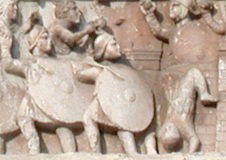
(photo by MM, and used under CCA 3.0 license) |
Further, every single shield pattern shown in the various Notitia manuscripts is round: those in O, P, M, and Ff, for example, have been drawn with a compass, and while those in W appear to be inked freehand, they are nonetheless clearly intended to represent circular objects. This is a problem, because while many shields depicted in other late Roman sources are shown as being circular, the majority are definitely not. Most are oval, like the ones shown on the left, depicted on the Arch of Constantine in Rome, erected between 312 and 315, and showing some of Constantine's troops at the siege of Verona in 312. Whether such late Roman oval shields were mostly bowl-shaped, curved around only one axis, or simply flat, is unknown. Ammianus (24.6.7) says that the shields of some soldiers at least were "incurva", and is is likely, from simple engineering grounds, that most were dished in this manner, but archaeological evidence is sadly lacking, and pictorial evidence is not exactly abundant.
More contemporary to the Notitia are the shields carried by the guards depicted on the so-called Missorium of Theodosius - a silver plate shown in replica to the right from the Museum of Merida; the original is dated to either 388 or 393. Again, these are far from being round. |
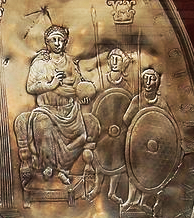
Photo by Manuel de Corselas, and released into the public domain. |
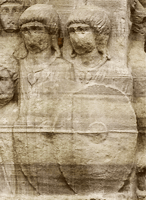
Photo (C) Simon Macdowall; used with kind permission of the author. |
Some contemporary representations are even less circular, like the "proto-teardrop" shields shown on the base of the Column of Theodosius, which have only 2-fold and not 4-fold symmetry, as they are longer below the boss than above it. These particular examples, being smaller than usual, probably belong to cavalrymen; the neck torques make one suspect the bearers might belong to the Scholae horseguards, which included many soldiers with ethnic German origins. This teardrop shape would become more common as the millennium progressed, and also become more elongated, eventually evolving into the medieval "kite" shield.
Nonetheless, there are good reasons to believe the patterns in the Notitia do depict late Roman shields - albeit distorted into a round shape from the more usual oval (there is no evidence that rectangular shields, as used in the Principate, were still in use by the time of the Notitia). Given the sheer number of shield patterns shown, nearly 300, the extra work that would have been involved in faithfully drawing shields of the correct proportions, as opposed to simple circles, would have have been very considerable indeed, so this "shortcut" is readily understandable. |
The most obvious point in favour of the patterns representing actual shields is that some of the patterns shown look just like shields depicted in other late Roman sources. For example, the Missorium of Valentinian, shown below (the original is now held in the Museum of Art & History in Geneva), while worn with use, shows guards with shields that clearly enough depict patterns that have obvious similarities with some of those shown in the Notitia.
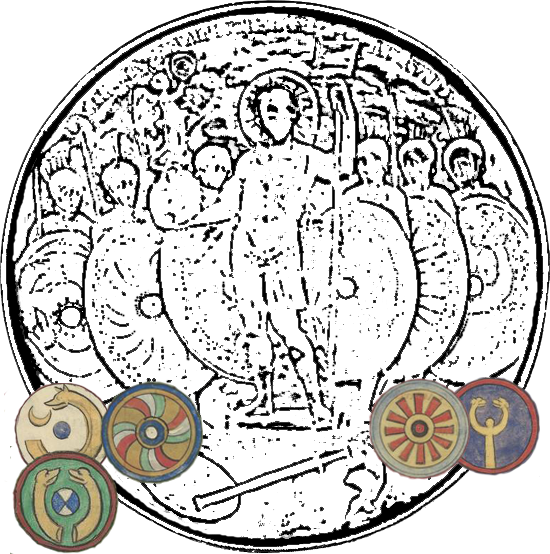
In particular, the guard on the extreme right (from the viewer's perspective) has a zoomorphic shield pattern that appears to be indistinguishable from that of the Notitia's Defensores, under the Magister Militum Praesentalis I; while the next guard in from the right, closer to the emperor, has a rayed shield pattern that appears to be very similar to that of the Notitia's Lanciarii seniores (or Lanciarii iuniores, for that matter; perhaps even more so given the pattern of the Lanciarii iuniores has more rays). The shields carried by the two middle guards are too worn to make any significant details out beyond the fact the inner right-hand one has a broad rim, and the inner left guard has a broad double rim (it may represent the other of the Lanciarii seniores/iuniores pair), but the middle of the left three shields carries a whirlygig pattern, like that of the Notitia's Constantini Dafnenses, but mirror-imaged, while the shield of the far left guardsman shows a large double-headed draco. This exact motif is not actually depicted in the Notitia, where dracos are either singular, as with the Equites Marcomanni, or oriented vertically, as with the Equites Mauri alites (and in this particular case, they look less like serpents and more like Ostrich heads), or are part of a pillar design, as with the previously mentioned Defensores, but all the components are represented. One should bear in mind that the Notitia shows the patterns of only a minority of the units listed therein, so one should not expect all units shown in other sources to have a corresponding Notitia pattern, even if the units kept the same shield pattern eternally, which they clearly did not.
Another example comes from a silver hoard that was unearthed in Marengo (Alessandria) in Italy in 1928; one of the items found was a fragment of a gilded silver belt showing a trophy of arms. One of the shields depicted, that on the left in the picture shown below, bears essentially the very same pattern as depicted in the Notitia for the Secundani Italiciani: a cross bearing multiple inset roundels or buttons.
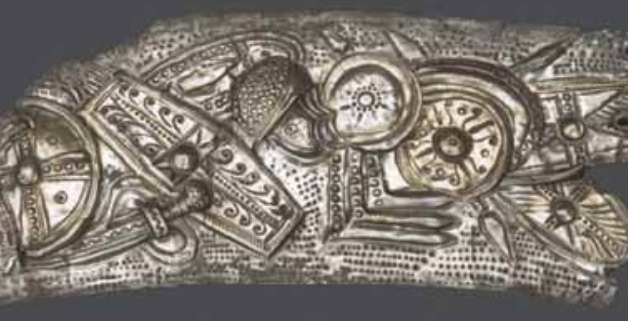
The second point in favour of the patterns shown being shields relate to the pictures accompanying each Magister Officiorum, both east and west. These officers controlled various armaments production facilities, and the Notitia spells out what each facility made, such as swords, catafract armour, shields, etc. The pictures show these production items, and the shields shown have patterns that are no different in form or execution from any of the other round patterns shown elsewhere in the document.

Return to the Notitia index page.